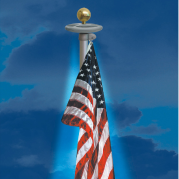History of the First U.S. Navy Jack, the Don't Tread on Me Flag
The Rattlesnake Symbol
The rattlesnake has long been an important American emblem. In 1751 Benjamin Franklin published an article in his Pennsylvania Gazette suggesting the colonists send rattlesnakes to Britain in return for the convicts they sent to America. Several years later during the French and Indian War, what is believed to be the first political cartoon published in an American newspaper was printed in the Pennsylvania Gazette. It depicted a drawing by Franklin of a snake cut into eight pieces, with each piece representing a colony. The motto below it was "Join or Die", showing the importance of unity among the colonies.
Native to America, rattlesnakes produce a loud rattling noise when threatened. Unless they are provoked or stepped on, rattlers will not attack. They do not surrender in an attack, and with teeth like hypodermic needles and debilitating, toxic venom, they are truly dangerous animals to entice. Using the rattlesnake image on a flag shows unity and power or it can be conceived as a threat. The image in essence is meant as a warning that America will attack when provoked and won't give up, just like the rattlesnake.
During the American Revolution, the rattlesnake was a symbol of rebellion against colonial British rule. The unity of the colonies made them a powerful force. One of the first snake flags in use was Christopher Gadsden’s "Don’t Tread on Me" flag. Known as the Gadsden flag, it displays a coiled rattlesnake on a bright yellow field with the motto "Don’t Tread on Me." This design and motto would inspire a number of other flags, including the First Navy Jack.
The First Navy Jack
Much debate has arisen about whether or not the First Navy Jack was flown by Commodore Esek Hopkins on the Alfred, flagship of the Continental fleet, in January, 1776. Described as a "strip’d jack" in the "Signals for the American Fleet," the flag could have been the First Navy Jack or just a plain red and white striped jack that was commonly used by American merchant ships. Conceived by Commodore Hopkins in 1775, the First Navy Jack is shown as having 13 alternating red and white stripes with an uncoiled rattlesnake and the "Don’t Tread on Me" motto. It was first used as a signal to engage the enemy.
Whitney Smith, Vexillologist and director of the Flag Research Center, confirms that the original design of the First Navy Jack is not known. Published in 1880, William Preble’s book History of the Flag of the United States, depicts a slightly different "Don’t Tread on Me" Navy ensign. Historians agree that Preble’s rare color plate probably shows the traditional design of the First Navy Jack flag, and it developed into the flag we know today.
Ships that Flew the First Navy Jack
Beginning in 1977 the ship with the longest period of active service was to display the First Navy Jack until decommissioned or inactive. The flag is then passed to the next ship with the longest period of active service.
- USS Dixie (AD-14) The USS Dixie was commissioned on April 25, 1940 and received the First Navy Jack in April 1981. It was decommissioned in 1982. Known as "Dependable Dixie," the ship is known for repairing destroyers in World War II, the Korean War and Vietnam.
- USS Prairie (AD-15) The USS Prairie was commissioned on August 5, 1940. After the USS Dixie’s (AD-14) decommission in 1982, it became the oldest ship in active service and received the First Navy Jack flag. Known as “the Oldest and the Best,” the ship was a destroyer tender, and year after year gained more female crewmembers until they numbered in the hundreds. It was decommissioned in 1993.
- USS Mauna Kea (AE-22) The Mauna Kea, an ammunition ship named after a volcanic peak in Hawaii, was commissioned on March 30, 1957. It was decommissioned in 1995, and in 2006 the ship was used as a target during the naval exercise RIMPAC. The ship reluctantly sunk off the coast of Hawaii.
- USS Independence (CVA or CV-62) The USS Independence (CV-62) was commissioned on January 10, 1959 and received the First Navy Jack from the Mauna Kea in 1995. Deemed "Freedom’s Flagship," the attack aircraft Carrier was decommissioned in 1998, after participating in almost every major naval operation in the four decades it was commissioned.
- USS Kitty Hawk (CV-63) The USS Kitty Hawk (CV-63) was commissioned on April 29, 1961 and received the First Navy Jack from USS Independence in 1998. This aircraft carrier still proudly displays the flag and has recently participated in Operation Iraqi Freedom. The USS Kitty Hawk is scheduled for decommission in 2008, when it will be replaced by a Nimitz-class aircraft carrier.
On September 11 (Patriot Day), 2002, all Navy ships began flying the First Navy Jack and continue to do so throughout the global war on terrorism. A flag steeped in American history that has been a source of inspiration in every war serves as a reminder of our nation’s origin. The first flag was given to Commodore Clayton Saunders and flown on the USS Rushmore (LSD 47). During the ceremony Saunders said,"this flag represents a renewed commitment by the Navy to our first principles, to secure freedom both at home and abroad."
References
- Gadsden Flag History.
- USS Mauna Kea (AE 22) Unofficial US Navy Site.
- Flag: An American Biography by Marc Leepson 2004.
- The U.S. Navy’s First Jack Naval Historical Center 2003.
- "A Brief History of the U.S. Navy Jack" Navy Office of Information.
- "All U.S. Navy Ships to Begin Flying First Navy Jack on Patriot Day"
- "U.S. Navy Announces CVN to Replace Kitty Hawk in 2008" U.S. Department of Defense.
Didn't find what you were looking for, or just have a new product suggestion? Please email us at: FlagProductSuggestion@OnlineStores.Com
Copyright © 2009 Online Stores PA LLC All Rights Reserved



















